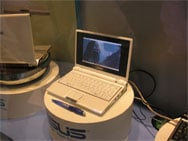ASUS Eee PC Hands On Preview
The ASUS Eee PC: A Closer Look
One of the biggest news stories out of this year’s Computex wasn't of a new chipset, GPU, or graphics card, but rather of the announcement of the ASUS Eee PC, a small, slim, and light portable computer that is priced at $199. Introduced by Jonney Shih, Chariman and CEO of ASUS at Intel’s keynote address the first day of the show, the Eee PC has already made headlines world wide.
The Eee PC’s main competition is the One Laptop Per Child (OLPC) project that originally aimed to bring to market a laptop priced at $100 for children in developing countries. However, the OLPC project has seen numerous delays and even a price increase to the $170 range.
Not only have we had the chance to actually use the ASUS Eee PC, we can also confirm some important new specifications of the notebook. The Eee PC is running a version of Intel’s 910 mobile chipset, it uses a 900MHz Intel Dothan based Pentium M CPU, it has 512MB of DDR2 memory, full 802.11g wireless capability, and a flash-based hard drive. There will be at least two different models of the Eee PC, with the $199 version using a 4GB flash hard drive and the $299 version using a 8GB drive.
Although 4GB of storage is extremely small when you consider that the industry is shipping 750GB hard drives on the desktop and 200GB+ hard drives on the notebook front already, the 4GB flash drive keeps costs very low, and cheap external storage can very easily be added to the Eee PC.
Another important thing to note is that although the ASUS Eee PC will directly compete with the OLPC project, the Eee PC wasn’t designed solely to bring personal computing to children in third world countries. ASUS plans to use the Eee PC to give people of all ages and from all corners of the globe access to their very own computer. The Eee PC will be a great first computer for people that have never been able to afford their own before, but will also appeal to experienced computer users that just can’t afford spending $2,000 on a UMPC that probably isn't much more powerful than the Eee PC.
One of the first things that you notice when picking up the ASUS Eee PC 701 is the fact that it is so light. The Eee PC weighs in at only .89 kilograms, which translates to just around 2 pounds. The keyboard on the Eee PC is slightly crammed and smaller than most notebook keyboards due to the Eee PC’s smaller form factor. It very closely resembles the size of the keyboard used in the Dell Inspiron 710, which makes it ideal for emails, web surfing, or short papers, but could become a nuisance when writing for extended periods of time and for those that are used to full-sized notebook and desktop keyboards.
On the Eee PC’s left side panel, the notebook has two USB 2.0 ports, an audio and microphone port, a 10/100 Ethernet port, and a 56K phone modem port. To show just how thin the Eee PC is, I used a NT$10 coin, which is similar in size to a
The right side panel of the Eee PC 701 has two more USB 2.0 ports, a VGA output, and even a flash card reader. The notebook uses a 4 cell battery that gives it just around 3 hours of battery life when it is on the move. As you may have noticed, there are no optical drives included with the Eee PC, and there is no room to add any to the notebook itself, so any DVD burners will have to be installed externally through one of the Eee PC 701’s four USB 2.0 ports.
Heat wise, the Eee PC 701 felt a bit warm to the touch, likely due to its non-stop use throughout the day on the show floor at Computex. It was however very quiet and the lack of spinning hard and optical drives made for a near silent experience.















